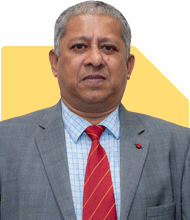Ramalingam Kalirajan |8192 Answers |Ask -Follow
Mutual Funds, Financial Planning Expert - Answered on Apr 23, 2024
He has an MBA in finance from the University of Madras and is a certified financial planner.
He is the director and chief financial planner at Holistic Investment, a Chennai-based firm that offers financial planning and wealth management advice.... more

i have taken voluntary retirement presently the age is 56 and plan to invest about 20-25 Lakhs, I shall also be earning a monthly pension of Rs. 32,000/- approx. Can you please suggest how to invest about 20-25 lakhs
Given your age and the desire for a stable investment, consider a mix of both equity and debt instruments to balance growth and safety. Here's a suggested allocation:
Emergency Fund: Ensure you have 6-12 months of living expenses in a liquid fund or a high-yield savings account for unforeseen expenses.
Fixed Deposits: Consider allocating a portion, say 30-40%, in fixed deposits or short-term debt funds. These provide stability and predictable returns.
Debt Funds: For another 30-40% of your corpus, consider investing in diversified debt funds or corporate bond funds. They offer better returns than FDs with moderate risk.
Equity Mutual Funds: With the remaining 20-30%, you can consider investing in balanced funds or hybrid equity funds. These funds provide exposure to equity markets while also having a debt component to reduce volatility.
Pension Plans: Given your pensionable age, consider investing a small portion in an immediate annuity plan or a pension scheme to further secure your monthly income.
Remember, the key is diversification and periodic review. As you move forward in your retirement journey, it might be beneficial to consult with a financial advisor to tailor this strategy further to your needs and goals.
You may like to see similar questions and answers below
Sanjeev Govila |458 Answers |Ask -Follow
Financial Planner - Answered on Feb 05, 2024
Ramalingam Kalirajan |8192 Answers |Ask -Follow
Mutual Funds, Financial Planning Expert - Answered on Aug 21, 2024
Ramalingam Kalirajan |8192 Answers |Ask -Follow
Mutual Funds, Financial Planning Expert - Answered on Aug 07, 2024
Dr Dipankar Dutta |1093 Answers |Ask -Follow
Tech Careers and Skill Development Expert - Answered on Apr 05, 2025
Prof Suvasish Mukhopadhyay |552 Answers |Ask -Follow
Career Counsellor - Answered on Apr 05, 2025
Prof Suvasish Mukhopadhyay |552 Answers |Ask -Follow
Career Counsellor - Answered on Apr 05, 2025
Prof Suvasish Mukhopadhyay |552 Answers |Ask -Follow
Career Counsellor - Answered on Apr 05, 2025
Prof Suvasish Mukhopadhyay |552 Answers |Ask -Follow
Career Counsellor - Answered on Apr 05, 2025
Prof Suvasish Mukhopadhyay |552 Answers |Ask -Follow
Career Counsellor - Answered on Apr 05, 2025
Prof Suvasish Mukhopadhyay |552 Answers |Ask -Follow
Career Counsellor - Answered on Apr 05, 2025
Prof Suvasish Mukhopadhyay |552 Answers |Ask -Follow
Career Counsellor - Answered on Apr 05, 2025
Prof Suvasish Mukhopadhyay |552 Answers |Ask -Follow
Career Counsellor - Answered on Apr 05, 2025
Mayank Chandel |2176 Answers |Ask -Follow
IIT-JEE, NEET-UG, SAT, CLAT, CA, CS Exam Expert - Answered on Apr 05, 2025




















